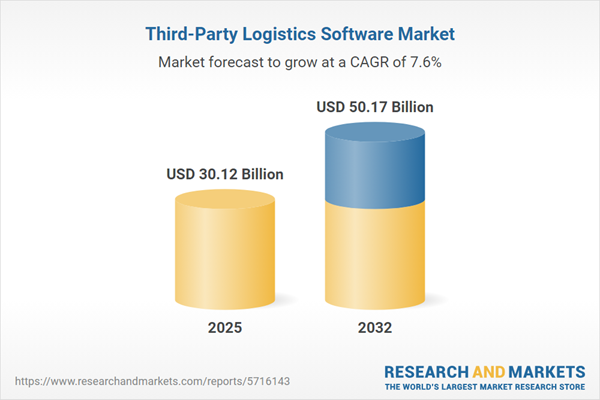Speak directly to the analyst to clarify any post sales queries you may have.
Third-party logistics software is transforming how executives manage complex global supply chains. By integrating advanced digital tools and automation, these platforms enable greater control, adaptability, and collaboration, supporting leadership priorities amid continually shifting logistics demands.
Market Snapshot: Third-Party Logistics Software Market
The global third-party logistics software market is advancing rapidly as organizations pursue comprehensive digital transformation within logistics. Modern technology platforms foster operational agility and enhance supply chain responsiveness in a competitive landscape. The sector is estimated to grow from USD 28 billion in 2024 to USD 30.12 billion by 2025, with an outlook reaching USD 50.17 billion by 2032, reflecting a steady compound annual growth rate (CAGR) of 7.56%.
Key factors driving this momentum include increased cloud adoption, applied artificial intelligence analytics, and robust global integration. Senior leaders are leveraging improvements in real-time supply chain visibility, automated compliance, and wider platform interoperability that support complex, multi-market operations.Scope & Segmentation
- Application Types: This software encompasses freight forwarding, transportation management, AI-driven route planning, automated order processing, IoT-enabled shipment tracking, warehouse robotics, and live inventory monitoring, each enhancing operational workflows and responsiveness across supply chains.
- Deployment Modes: Solutions range from cloud-based and hybrid deployments to on-premises installations, all customizable to meet distinct scalability, security, and regulatory needs for diverse organizations.
- Organization Sizes: Platforms are available for large enterprises and small to medium-sized businesses, enabling tailored operational models and supporting varied growth objectives worldwide.
- End-User Industries: Key sectors served include food and beverage, healthcare, pharmaceuticals, retail, and manufacturing, with platforms addressing needs such as temperature-sensitive logistics, precise inventory coordination, and omnichannel fulfillment.
- Service Types: Providers offer consulting, implementation, ongoing maintenance, and user-specific training, maximizing technology uptake, stability, and value extraction through the software lifecycle.
- Regional Coverage: Coverage extends across the Americas, Europe, Middle East and Africa, and Asia-Pacific, ensuring solutions adapt to local standards, digitalization requirements, and specific cross-border trading conditions.
- Leading Vendors: Notable vendors include Oracle Corporation, SAP SE, Manhattan Associates, Blue Yonder Group, Descartes Systems Group, MercuryGate, E2open, C.H. Robinson Worldwide, 3G Logistics Software, and Trimble, each supporting different sector requirements and regulatory frameworks.
Key Takeaways for Senior Logistics Leaders
- Adoption of AI and IoT technologies enhances proactive risk management and flexible planning, empowering organizations to anticipate and address disruptions.
- Real-time analytics and automated processes assist executives in resource allocation, enabling supply chain strategies that align with broader business objectives.
- Flexible deployment options promote smooth adaptation to evolving mandates and support agile responses to organizational change.
- Integrated digital platforms simplify collaboration and information sharing both within the organization and across supply chain partner networks.
- Modular architectures equip companies to stay responsive to regulatory shifts and changing operational targets without incurring major system transitions.
- Advanced compliance tools help organizations efficiently navigate multi-regional regulations and maintain uninterrupted operations globally.
Tariff Impact & Agile Software Adaptation
Ongoing changes in US tariffs continue to complicate cross-border logistics, driving up compliance demands. Advanced third-party logistics software supports organizations in modeling tariff scenarios, adapting transport strategies, and preemptively managing regulatory risks. These features help maintain streamlined operations, control costs, and support supply chain reliability as trade regulations evolve.
Methodology & Data Sources
This analysis is grounded in direct interviews with logistics and IT leadership, independent market research, and a comprehensive assessment of compliance environments. User feedback and supply chain stakeholder input anchor findings in practical, real-world contexts, highlighting technology’s operational impact.
Why This Report Matters
- Informs decision-makers on optimal alignment between logistics software and organizational needs, enabling effective digital transformation initiatives at scale.
- Enhances the ability to manage compliance complexity and maintain reliable supply chain performance in evolving global markets.
- Offers clear benchmarks for software comparison, supporting precise and thorough technology evaluation tailored to business priorities.
Conclusion
Third-party logistics software enables leaders to build more transparent, resilient supply chains. By unifying data and processes, these solutions foster informed management and lasting organizational agility in a dynamic business environment.
Additional Product Information:
- Purchase of this report includes 1 year online access with quarterly updates.
- This report can be updated on request. Please contact our Customer Experience team using the Ask a Question widget on our website.
Table of Contents
3. Executive Summary
4. Market Overview
7. Cumulative Impact of Artificial Intelligence 2025
Companies Mentioned
The companies profiled in this Third-Party Logistics Software market report include:- Oracle Corporation
- SAP SE
- Manhattan Associates, Inc.
- Blue Yonder Group, Inc.
- Descartes Systems Group Inc.
- MercuryGate International, Inc.
- E2open, LLC
- C.H. Robinson Worldwide, Inc.
- 3G Logistics Software, LLC
- Trimble Inc.
Table Information
| Report Attribute | Details |
|---|---|
| No. of Pages | 198 |
| Published | October 2025 |
| Forecast Period | 2025 - 2032 |
| Estimated Market Value ( USD | $ 30.12 Billion |
| Forecasted Market Value ( USD | $ 50.17 Billion |
| Compound Annual Growth Rate | 7.5% |
| Regions Covered | Global |
| No. of Companies Mentioned | 11 |









